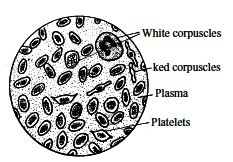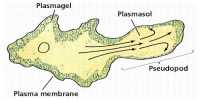Blood is a kind of liquid connective tissue. The blood of toad is red. It is produced from the mesoderm cell layer of the embryo. Blood is divided into two main components, Plasma and Blood corpuscles.
Plasma: Plasma is the main component of blood. It is trasparent. slightly alkaline substance and light yellow coloured. Besides water in the plasma, food, hormone, mineral salt, carbon-dioxide, fibrinogen and various gaseous components remain in dissolved condition. In plasma the blood corpuscles remain suspended. The primary function of the plasma is to transpot the blood corpuscles and other substances to different parts of the body.
Blood corpuscles are mainly of three types, such as:
- Red blood corpuscle or Erythrocyte.
- White blood corpuscle or Leucocyte.
- Platelets or Thrombocyte.

Fig: three types of Blood corpuscles
Red blood corpuscle: The red blood corpuscle is oval, biconvex and nucleated. The reddish colour of blood is due to the presence of haemoglobin. Haemoglobin is a kind of iron mixed protein, The amount of this corpuscle is highest in blood. Red blood corpuscles are produced in bone marrow, liver and spleen. Haemoglobin easily mixes with oxygen to form oxyhaemoglobin. In a similar way oxyhaemoglobin being reduced transforms into haemoglobin and the red blood cell supplies oxygen to the cells.
White blood corpuscle: White blood corpuscle is bigger in size, less in number, colourless and has nucleus. White corpuscles are produced in bone marrow, spleen, and lymph glands. They can change shape like the Amoeba and destroy germs. If necessary they may come out from the thin membrane of blood vessel and destroy harmful substances if there is any.
Platelets: Among the blood cells the smallest corpuscles are the platelets. These cells are spindle shape and are nucleated. These are originated in the bone marrow. Platelets help in the clotting of blood.












